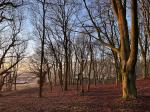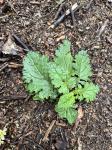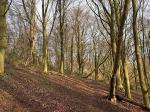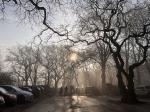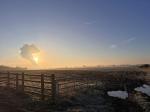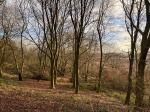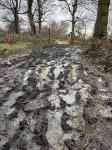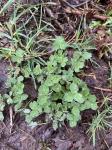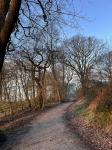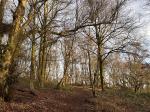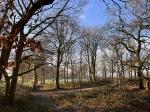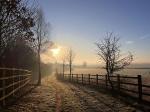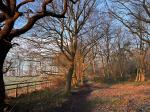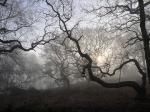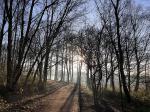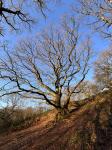Brayton Barff Through the Seasons.
Set in the Vale of York, South West of the market town of Selby and between the villages of Thorpe Willoughby and Brayton, lies Brayton Barff, a sandstone Hill approximately one hundred and fifty feet in height which was formed by glacial movement during the last Ice Age. It is a significant landmark in an otherwise flat landscape.
Today the site is primarily owned by Yorkshire Water with Selby District Council owning a small patch of the land adjacent to the A63 Selby bypass. A large underground reservoir occupies the centre of the site which delivers water to around 4.7 million customers throughout Yorkshire.
Within the Barff woodland over 40% of the trees are Sessile Oak which are generally found in semi natural woodlands in the north of the country. These trees are so called because its acorns are not held on stalks, like those of the English Oak (Pedunculate), but attached directly to the outer twigs. There are also several English Oak trees as well as some cross-hybrid oaks. These trees are known to support many species of flora and fauna, invertebrates, mosses, lichen and fungi.
During the Victorian times it is thought that the shipbuilders on the east coast would come over to the Barff for selected cuts of timber to build their sea going vessels.
The Barff also has a variety of other trees including Silver Birch, Beech, Sycamore, Holly, Rowan, Scots Pine, Alder, Hawthorne and European Larch. There are also several Yew, Willow, Hazel, Horse Chestnut and Wych Elm. As with similar woodlands there are a variety of bushes, including Honeysuckle, Elderberry, Gorse, Broom and Buddleia.
The history of Brayton Barff is quite vague, apparently during 1803 a beacon was lit on the Barff when the country was threatened with an invasion by Napoleon. In May 1935, to celebrate King George V's Silver Jubilee, a Bonfire was lit on the Barff as part of the celebrations.
Early issues of Ordnance Survey Maps dated 1903 clearly show a rifle range on the Barff, extending out to Mill Lane. During the 
Between 2001 – 2004 the A63 Selby bypass, 10km twin lane single carriageway was constructed which severed the South West corner of the Barff, adjacent to Selby Golf Course and resulted in a slight redesign of several holes on the golf course. Wooden fencing was erected as a result of this new road running alongside of the Barff and a footbridge constructed over the ‘new road’ following the line of the Bridal way which extends from Mill Lane. Around 2005/2006 a definite 2metre wide limestone aggregate footpath was laid forming a circular path around the outer edges of the woodland. This footpath is approximately 1.2 miles in length and takes about 30 minutes to circumnavigate at a leisurely pace.
In 2012 the Barff was declared an Ancient Oak Woodland and as such throughout 2012 and 2013 significant work had been carried out by the relevant agencies to cut and remove large swathes of non-native trees, creating at that time huge scars on the landscape. Some three years later the planting of the native trees have become well established and are flourishing. Ongoing maintenance work on the footpath around the bottom of the Barff was completed during the Summer of 2016.
A second phase of woodland maintenance commenced during the Autumn of 2019 with the removal of many old and diseased trees and the cutting back of the Gorse and Broom bushes, especially adjacent to the ‘bypass trail’, this work continued through till March 2020 with re planting continuing into April 2020.
Brayton Barff is a popular site for walkers and bird watchers alike and a path circling the outer perimeter of the Barff makes a pleasant thirty minute walk, giving views looking over towards Selby and the village of Brayton as well as the power stations of Drax and Eggborough..jpg)
For the early risers it is a great place to see some stunning sunrises over the villages of Brayton looking towards Drax Power Station, the same with the Sunsets looking over towards Eggborough and Monk Fryston.
The Barff changes with the Seasons and every visit can reveal something new, the woodland is a haven for wildlife. Records show that since 1982 one hundred and twelve species of bird have been seen in the woodland and at least 40 of those have bred here, including Tawny Owl, Buzzard, Green Woodpecker, Spotted Flycatcher, Goldcrest and Nuthatch to name just a few. On average over 70 species of bird are recorded each year. Further details of the bird life on the Barff can be found on the Brayton Barff Group Facebook page, especially the posts from Derek Cooper. Today ‘The Friends of Brayton Barff group’ led by Derek and a small team of volunteers help keep and maintain the cleanliness of the site as well as recording the wildlife and bird sightings.
The Barff is also home to fifteen different species of mammals, including Muntjac Deer, Pipistrelle Bat, Fox, and Field Vole.
Over eighty species of plant and wildflowers have been recorded, included Bee Orchid, Northern Marsh Orchid, Wood Anemone, Marsh Ragwort, Bluebell, White Bluebell, Bittersweet and Purple and White Foxgloves. Over twenty species of Butterfly have been recorded, including Marbled White, Brown Angus, Speckled Wood, Comma and Brimstone.
During the Autumnal months fungi thrives in this woodland environment, species including Fly Agaric, Beefsteak Tree Fungi, Chicken of the Wood, Sulphur Tufts, Stinkhorn, Ink cap, Puffballs and Hoof Bracket are just some of the many varieties that can be found here.
Click on the galleries shown below to expand the albums.
February 2024
Friday 2nd February 2024, a dull, cloudy, and overcast morning, very mild for this time of year at 9c, brightening up later. Our resident Grey Squirrels were becoming more active and adventurous. The Song Thrush has been very vocal along with Robin, Wren, and Great Tits. It was good to hear the Greater Spotted Woodpecker drumming away this morning. Small clusters of Nettles are beginning to grow, as are the Brambles. The Honeysuckle bushes on the top of the Barff are continuing to leaf up at an alarming rate.
Saturday 3rd February 2024 was another dull, cloudy, and overcast morning, it was quite mild at 10c, the early morning drizzle made for a very damp walk this morning.
Sunday 4th February 2024 and what a contrast to yesterday, it was still very mild at 10c and a lovely, bright and breezy pleasant walk with the dogs.
Monday 5th February 2024 a very mild start to the day, 10c again, with a breezy northwest wind, it was a dull and cloudy morning with rain later in the day. There were lots of Buntings in the Maize field again. Song Thrush, Wrens and Long Tailed Tits were quite vocal throughout the woodland this morning.
Tuesday 6th February 2024 was another dull, cloudy and overcast morning, it was very mild at 11c, with rain towards the end of the walk.
Wednesday 7th February 2024 Woke up to a cold overnight frost this morning. It was a bright start to the day with a watery sun rising from behind Drax Power Station. There was lots of activity in the old Maize field, I spotted and heard several Brambling, accompanied with lots of Tree Sparrows, and Reed Buntings.I watched the Buzzard for as good five minutes as it flew between the trees in the upper wood to the left of the service road this morning. A pair of Thrush’s were singing their heads off along the bypass trail this morning. As I moved further round the woodland I was accompanied with several Robins and Chaffinch which kept flitting from one tree to another. Wrens were a constant too, often chirping away in the background but occasionally coming to the fore. The Bluebells are pushing through at an alarming rate, along with Creeping Buttercup, Cow Parsley, and Celandine
Thursday 8th February 2024 A cold, dull and overcast morning, 2c, rain was imminent. A Yellow weather warning had been issued for snow today. Wrens, Robins and Song Thrush very vocal this morning. By 9.00am it had started to rain which changed to sleet and snow by mid-morning and continued throughout the afternoon changing back to rain by mid-afternoon. Rain continued late into the night. A strengthening NE wind made it quite unpleasant if you were unfortunate enough to be caught in it.
Sunday 11th after a wet and rainy night there was a slight respite this morning, temperature at 8.00am was 7c. There was little wind, the ground was completely waterlogged. The tracks of the main perimeter path are quite treacherous at the moment with thick squelchy mud. Very noticeable was the birdsong this morning, a Greater Spotted Woodpecker was drumming away within fifty metres of the car park, followed by Song Thrush, Coal Tits and Robins also contributing, their song certainly lifts the spirits on a dull, cloudy, and overcast day. Love them or hate them, the Grey Squirrels were more active than usual, chasing each other up and around the trees at 100mph, I watched several coming out of the Maize field and running across the Perimeter footpath and up into the safety of the trees. It is nice to see the Bluebell shoots pushing through the leaf litter in many places around the woodland.
Monday 12th, I have said this many times before but what a difference a day makes on the Barff, compared to yesterday. This morning there had been a light overnight frost, it was still chilly at 7.45am just 2c, but the sun was rising over the power station, and it turned out to be a very pleasant walk around the woodland. Within minutes of arriving a Buzzard flew high above me leaving the security of the trees to search for food over the Maize field to my left, just one beat of its wings and it must have glided over one hundred yards before it started to circle the field in search of its prey. It was a still morning with very little wind at all. Birdsong filled the air; several Robins were contently singing their heads off as we walked past them. A Greater Spotted Woodpecker was busily drumming away on one of the old Silver Birch trees, the sunlight was just beginning to break through the trees on the Barff, leaving its very pleasant shadow on the woodland floor. The Song Thrush were on good form too this morning, I think they sing nicer in the dappled sunlight, I must have heard at least six of them as we continued our morning dog walk. It was good to hear the Nuthatch calling today, they have been quiet of late, I know we usually have several pairs residing amongst the trees. It looks as though we have had some deer on the Barff overnight savaging for food, they have left some telltale signs around several of the holly bushes. They have a particular diet and do not generally eat holly due to its toxicity and unpleasant smell, though they may browse on holly leaves and stems, break branches, or damage the bark when they are hungry or when they rub their antlers on the plants. Birdsong was especially noticeable as I left the top of the Barff and headed over towards the old pumping station, a pair of Song Thrushes were singing their heads off accompanied by our resident Coal Tits, Robins and Wrens, it really does lift the spirits on this chilly morning. It is nice to see the sheep back in the fields opposite the old farm shop, busily grazing in the field. Another Greater Spotted Woodpecker was hard at work drumming on one of the old Oak trees adjacent to the service road.
Wednesday 14th February was a very mild morning the temperature was12c at 7.15am. The heavy overnight rain had made it very muddy and slippery underfoot.
Friday 16th February was another dull, cloudy, and overcast morning, the temperature at 7.30am was 9c. The heavy overnight rain made it very wet underfoot though it was nice to see some sunshine mid-morning. Lots of birdsong around the Barff including Song Thrush, Great Tit, Wren, Coal Tit and Blue Tit, which just lifted the spirit somewhat.
Sunday 18th February was a very mild morning, the temperature at 7.30am was 12c. The heavy overnight rain made it a very wet and muddy morning walk around the woodland.
Monday 19th February was another wet and rainy morning, 6C with a light westerly breeze at 7.45am. The rain making it very wet and slippery underfoot. The Daffodils have come in to flower on the Barff summit this week, several weeks earlier than last year, due to the milder, wetter conditions and lack of prolonged frosts, Creeping Buttercup, Lesser Celandine, and nettles are beginning to grow at an alarming rate.
Thursday 22nd February woke up to heavy rain, and the rain continued all morning, The Barff was like a quagmire, large muddy, slippery puddles and pools of water lying on the woodland floor. I had to put the dogs’ waterproof jackets on Meg and Gracie this morning such was the intensity of the rain, much to their disgust. Despite the rain it was good to hear the resident Thrushes blasting out their tunes this morning. It felt quite mild with the temperature just touching 5c at 7.30am and a faint westerly breeze.
Saturday 24th what a contrast this morning to wake up to an overnight frost instead of the rain of the past few days. It was a beautiful morning, cold at –1c at 7.15am as I arrived on the Barff, the sun was already rising above Drax power station. There was a slight mist in the air just hovering above the ground rising from the warm earth and hitting the cold morning air. Rainfall this month is well above average for this time of year and in places we have had twice as much rain this month as we did last month, no wonder the surrounding fields are still waterlogged.
Monday 26th February was a lovely morning with some sunny periods for a change. There was a cool westerly breeze which kept the temperature down though it was still very wet and muddy underfoot. There were lots of birdsong around the woodland including Wren, Robin, Great and Blue Tit, Song Thrush, and Nuthatch.
Thursday 29th February was a dull and overcast start to the day, overnight rain had made the ground quite muddy in places, especially on the top of the Barff. It was pleasantly mild at 8c at 7.30am although there was quite a cool light westerly breeze. Bird song was lovely to hear on a dull morning and lifted the spirits nicely, Song Thrush, Robin, Wren, and Coal Tits amongst the top contributors this morning. Robins and Chaffinch seem to follow me around the woodland always popping up in front of me, Blackbirds were busily flitting to and fro searching through the leaf litter for any sign of food. Walking through one of the upper plantings just off the main service road the Buzzard was flying just above my head, flying from tree to tree with ease, its massive wingspan narrowly missing the tree branches, such a beautiful sight to witness in this woodland setting. The Greater Spotted Woodpecker are becoming more noticeable in that I have heard them drumming in at least three different areas of the woodland. Nuthatch are becoming more visible too, flitting in and out of their usual nesting boxes.
Well, February has been and gone but what a month weatherwise. I was reading recently that we have had ten yellow weather warnings issued since the start of this year. It has certainly been a wetter month than normal with some parts of Yorkshire seeing twice as much rain as normal for this time of year. The County has also had one of the warmest Februarys on record, due primarily to the lack of frosts. The average temperature in England for February 2024 was 7.5°C, topping the previous record of 7.0°C set in 1990.
The warmer weather has seen a growth in the Bluebells which look to be two to three weeks earlier than they were this time last year, and the same with the Daffodils which have been in flower now for a week or so. Hurry up Spring.
|



